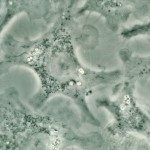Lien vers Pubmed [PMID] – 17178786
Infect. Immun. 2007 Mar;75(3):1237-44
Aspergillus fumigatus is the most prevalent airborne filamentous fungus causing invasive aspergillosis in immunocompromised individuals. Only a limited number of determinants directly associated with virulence are known, and the metabolic requirements of the fungus to grow inside a host have not yet been investigated. Previous studies on pathogenic microorganisms, i.e., the bacterium Mycobacterium tuberculosis and the yeast Candida albicans, have revealed an essential role for isocitrate lyase in pathogenicity. In this study, we generated an isocitrate lyase deletion strain to test whether this strain shows attenuation in virulence. Results have revealed that isocitrate lyase from A. fumigatus is not required for the development of invasive aspergillosis. In a murine model of invasive aspergillosis, the wild-type strain, an isocitrate lyase deletion strain, and a complemented mutant strain were similarly effective in killing mice. Moreover, thin sections demonstrated invasive growth of all strains. Additionally, thin sections of lung tissue from patients with invasive aspergillosis stained with anti-isocitrate lyase antibodies remained negative. From these results, we cannot exclude the use of lipids or fatty acids as a carbon source for A. fumigatus during invasive growth. Nevertheless, test results do imply that the glyoxylate cycle from A. fumigatus is not required for the anaplerotic synthesis of oxaloacetate under infectious conditions. Therefore, an antifungal drug inhibiting fungal isocitrate lyases, postulated to act against Candida infections, is assumed to be ineffective against A. fumigatus.
